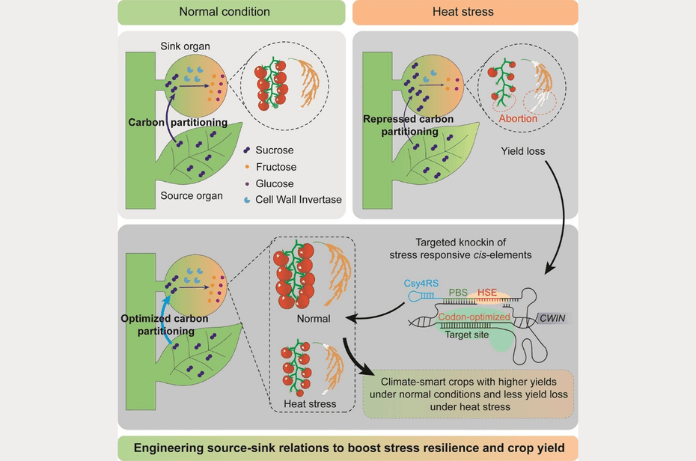The world is expected to reach a staggering 10 billion global population by 2050. Feeding this growing population will demand a 60% increase in agriculture productivity, but with the planet heating up, the challenge is monumental. A 2°C rise in temperature during the growing season could lead to yield losses of 3-13%, leaving humanity grappling with food shortages. How do we overcome this? Enter a groundbreaking novel breeding strategy to rapidly create climate-smart crops.
Their study, published in Cell, offers a beacon of hope: a novel approach to engineering climate-smart crops that not only thrive under normal conditions but also mitigate yield losses during heat stress. Let’s dive into how this revolutionary strategy works and why it’s a game-changer for global agriculture.
The Climate Crisis and Food Security
The effects of climate change are no longer a distant threat they are here, and they are wreaking havoc on our food systems. The culprit? Abiotic stress, including heatwaves, droughts, and fluctuating temperatures, all of which impair crop productivity.
With climate change predicted to worsen, scientists have sounded the alarm: to ensure global food security, we must develop crops that can withstand these harsh conditions. But traditional breeding methods are slow, expensive, and often fail to meet the demands of a rapidly warming world.
This is where Prof. XU Cao’s team steps in, pioneering an ingenious solution to this pressing problem.

Understanding the Source-Sink Relationship
Before delving into their groundbreaking strategy, it’s essential to understand the source-sink relationship, the cornerstone of crop yield and quality.
- Source tissues, like leaves, are responsible for producing photoassimilates, primarily carbohydrates such as sucrose.
- Sink tissues, like fruits, seeds, and roots, developing flowers, cotton fibers, and storage organs are net importers, which use or store photoassimilates.
The enzyme cell wall invertase (CWIN) plays a pivotal role in this process, converting sucrose into glucose and fructose within sink tissues. These sugars fuel fruit and seed development, influence sweetness, and even enhance the quality of grains like rice.
However, heat stress disrupts this delicate balance by suppressing CWIN activity, leading to energy deficiencies in sink tissues. The result? Poor reproductive development, reduced yields, and compromised crop quality.
The Breeding Strategy: A Breakthrough in Gene Editing
Recognizing the limitations of traditional methods, Prof. XU Cao from the Institute of Genetics and Developmental Biology (IGDB), under the Chinese Academy of Sciences. and his team developed a cutting-edge strategy: Climate-Responsive Optimization of Carbon Partitioning to Sinks (CROCS). This innovative approach hinges on the precise manipulation of CWIN genes in staple crops like rice and tomatoes.
Using high-efficiency, prime-editing tools, the researchers inserted a 10-base-pair heat-shock element (HSE) into the promoters of CWIN genes. This genetic tweak enhances the genes’ heat-responsive activity, ensuring optimal carbon partitioning to sink tissues even under stressful conditions.
The results of the new breeding strategies are nothing short of astonishing:
- Tomato Yields:
- Normal conditions: Increased by 14-47%.
- Heat stress: Yield increased by 26-33%, with 56-100% of heat-induced losses rescued.
- Improved fruit quality, including uniformity and sugar content.
- Rice Yields:
- Normal conditions: Boosted by 7-13%.
- Heat stress: Yield increased by 25%, with 41% of heat-induced grain losses rescued.
From Lab to Field: Real-World Applications
The CROCS strategy isn’t confined to laboratories it has been rigorously tested in diverse environments, including greenhouses and open fields. The team also expanded its application to other crucial crops like soybeans, wheat, and corn, making it a versatile solution for global agriculture.
The multi-season, multi-location trials confirm its efficacy, paving the way for a new era of climate-smart farming.
Why This Matters: Beyond the Numbers
While the statistics are impressive, the broader implications of this study are even more significant:
- Ensuring Global Food Security: CROCS offers a practical solution to feeding a growing population under changing climatic conditions.
- Advancing Genetic Engineering: The precise insertion of environment-responsive cis-regulatory elements sets a benchmark for future crop improvement strategies.
- Sustainability in Agriculture: By improving yields without expanding farmland, this strategy supports sustainable farming practices, reducing the environmental impact of agriculture.
The Road Ahead: What’s Next for CROCS?
As promising as the CROCS strategy is, its journey is far from over. The team is now focused on refining their gene-editing tools and expanding their work to include more crops. Additionally, partnerships with governments and agricultural organizations will be crucial in scaling up this technology for global adoption.

